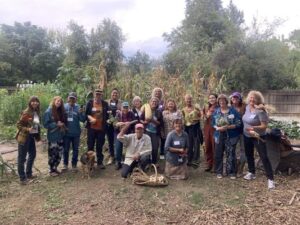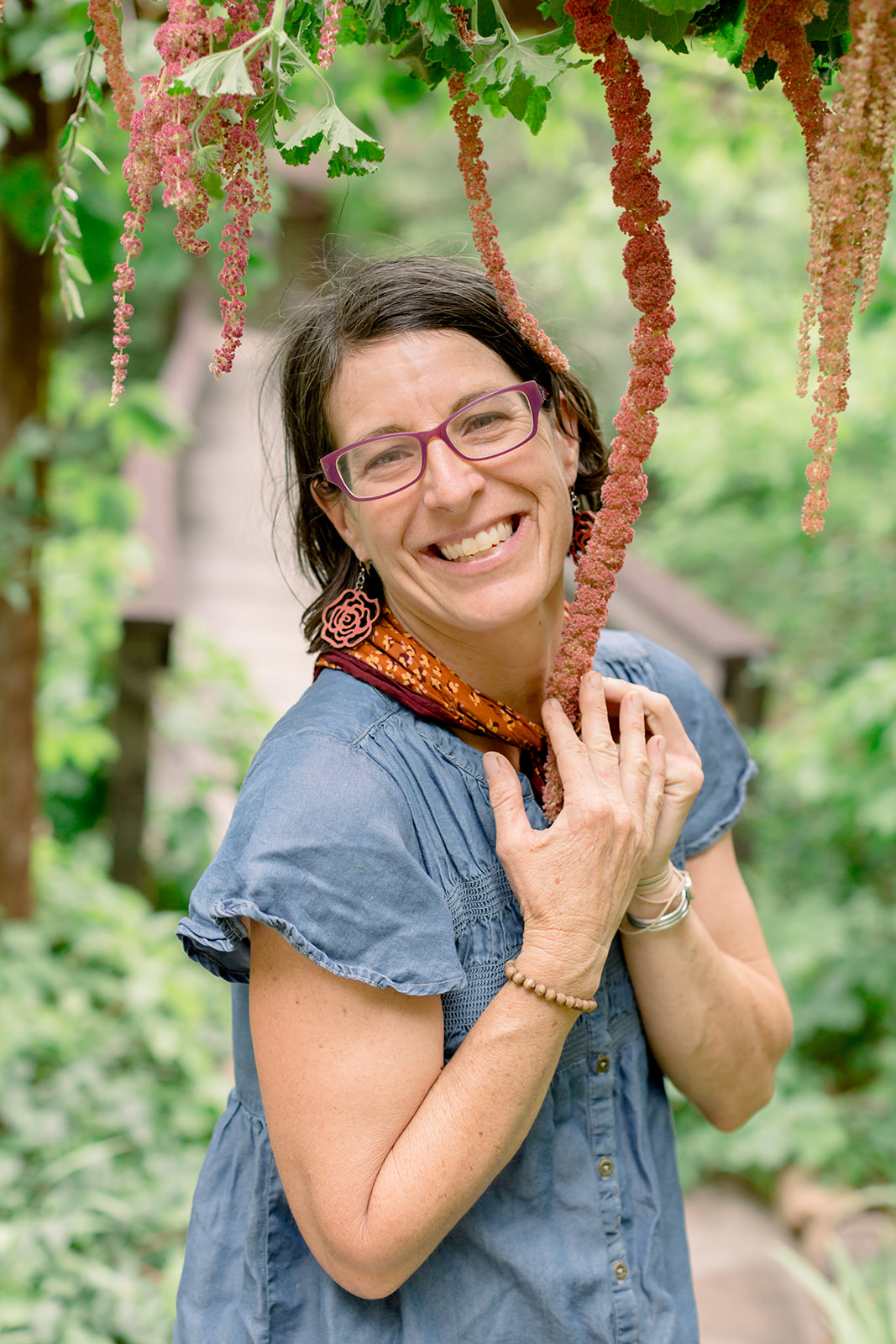Posted by Kate Watters on Nov 3, 2022
 It’s mid-October and the sky echoes with endless blue. A halo of deciduous trees embraces the change of season. The corn fields on our Rimrock farm have turned from green to golden, which means it is time to harvest.
It’s mid-October and the sky echoes with endless blue. A halo of deciduous trees embraces the change of season. The corn fields on our Rimrock farm have turned from green to golden, which means it is time to harvest.
Fifteen people—many of whom I have just met—are wandering through the fields in search of ears, as if on a treasure hunt. Flint is a type of corn used to make masa for tortillas, tamales or hominy for posole. Unlike sweet corn, which is picked fresh, flint corn must cure on the plants. The hard-like-flint kernels allow these varieties to be stored for long periods and be less prone to insect and rodent damage, all traits selected by ancient farmers.
The strangers in the corn fields are not a band of marauders, but a group of curious gardeners here for a day of Seed School. They are neighbors with homesteads, farm hands from nearby communities. My sister Kelly (who helped plant the corn) came from Tucson. They all came to save seeds.
I have been anticipating harvest day like a child waits for Christmas. The ears are camouflaged, so when you find one and unwrap it, it feels like winning a beauty lottery. No two ears alike in size, shape, or color. It’s a feast of diversity. Many are a deep, almost black-burgundy color, but all colors of the rainbow appear to be represented—red, orange, coral pink and golden ears freckled with explosions of blue and pink. The field is alive with snapping sounds and satisfied murmurs.
These two corn fields originated from different seed sources and therefore have unique stories that you can read about in previous Flag Live editions. One field is from seed I was given in 2018 by a Oaxacan farmer and his wife, an expert tamale maker. I planted the Oaxacan seeds at a farm-to-table garden in Oak Creek Canyon and it grew beautifully for two seasons. The yield was enough for the chef and me to make an epic posole, and several batches of tamales. When I left to start my own farm in 2020, I took some of the seeds with me.
The second field is from my neighbor Bill’s plants. I met Bill and his wife Belle at a delicious and memorable potluck last summer. Bill waxed poetically about his corn journey while he cranked out wood-fired pizzas from heirloom grains grown on their homestead. Bill has an innate curiosity and passion for seeds—especially grains. He spent the last 30 years co-founding several nonprofit projects and seed companies and co-directing Native Seed Search in Tucson. Now his energy is focused on reviving ancient grains (while growing and eating them) and teaching people how to save seeds. Four years ago, he set out to grow a great tortilla corn in his backyard by curating four different varieties, planting them together and then saving the seeds.
This spring, my sister Kelly and I helped Bill plant his corn, which involved poetry and an epic meal of corn tortillas and Anasazi beans. That evening’s conversation drifted from seeds to Bill’s stories of the challenges and rewards of being a foster parent through the years. It seemed like strangely similar territory to our food system—both broken with living beings in need of care and feeding.
These are challenging times to be a human or a seed. Five companies own 90 percent of seed varieties, and the majority are chemical companies. We have lost 90 percent of our food diversity. Climate change continues to wreak havoc in our backyards. My visit to Oaxaca, where I witnessed the deep connection between people and their food traditions, reminded me: seed selection has been going on around the world for thousands of years, as long as humans have needed to eat. Now, more than ever, we must re-learn the ancient technology of seed saving.
When you plant a seed or nurture any living being (human or otherwise) you cannot know the whole story of how your actions, or the environment influenced the outcome. You are part of a continuum. When we assumed the responsibility fostering Bill’s extra corn seedlings, the seed was also planted to teach a seed saving workshop together.
Meanwhile, back at Seed School, the students harvested all the corn that was ready from the two patches, separating the ears open from ears closed—a trait we wish to select for in the future. An open ear during monsoon season collects moisture and is prone to mold and worms. In the end Bill’s seed produced more corn overall by a landslide. There is more to the story of why, but I’ll save that for the farm tours.
Part of Seed School is enjoying a meal together from an array of garden goods, including homemade tortillas. The work of harvesting, separating, processing, grinding, and pressing the masa to make the tortillas is ancient and communal. The key ingredients are time, community and hunger. When there are many hands, much laughter and stories it eliminates the drudgery. The tortillas taste like earth and fire, and remind me of all the colorful shapes and sizes that corn assumed in Oaxaca. When corn is the center of your world, you naturally find countless ways to package meat, cheese, beans and grasshoppers inside it for maximum taste and calories.
When you grow corn, you enter an ancient relationship with the mother of culture: an 8,000-year-old, unspoken agreement to take care of one another. I have felt this motherly presence in my corn field, and as I write this, with a pot of posole corn simmering on the stove, the house fills with an aroma of motherly comfort. Fostering Bill’s corn seems so much easier than fostering the kids he cared for or the students my sister Kelly is teaching in Tucson. There are many things in the world that need our love and attention, including seeds.
Although I grow flowers for a living, the corn is sustenance for my earthly body and spirit. Sharing corn with people feels good and familiar, like learning a new song and finding the melody comes naturally. Each Seed School student went home with a handful of our corn seeds—selecting whatever colors and shapes they found appealing.
The journey of this seed continues with exponential possibility; generations of seed savers who came before us and those who continue take their food, gardens and seeds back into their own hands.
 It’s mid-October and the sky echoes with endless blue. A halo of deciduous trees embraces the change of season. The corn fields on our Rimrock farm have turned from green to golden, which means it is time to harvest.
It’s mid-October and the sky echoes with endless blue. A halo of deciduous trees embraces the change of season. The corn fields on our Rimrock farm have turned from green to golden, which means it is time to harvest.
